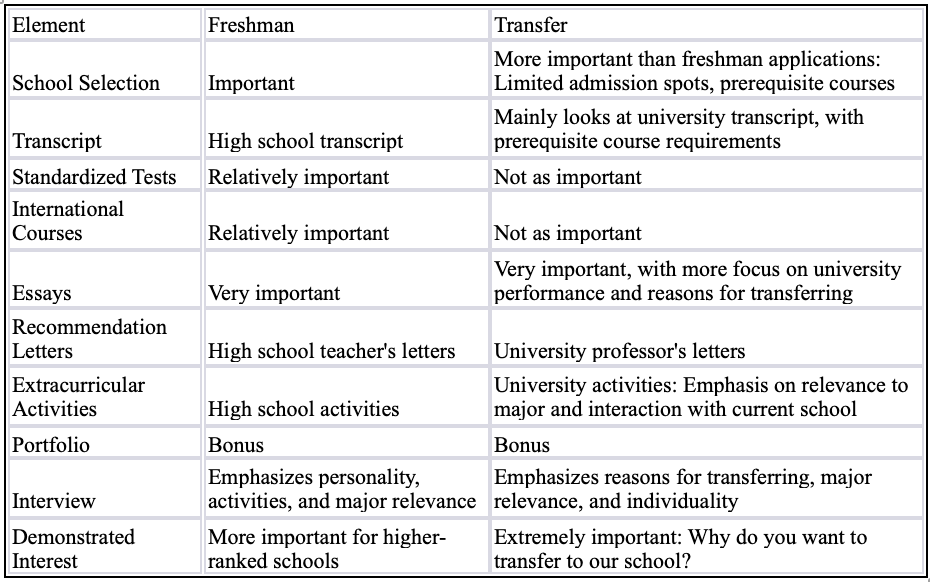Transfer Application 101
Differences Between Transfer and Freshman Applications

The Importance of School Selection
It lies in admission quotas and prerequisite courses. The preference for admitting transfer students varies among schools, leading to different admission quotas. For example, among Ivy League schools, Cornell is more welcoming to transfer students, while Brown admits very few transfer students each year due to its strong emphasis on general education in the first two years. Additionally, schools have specific preferences for transfer admissions to balance the intake of new students. Furthermore, differences in school retention rates contribute to variations in admission quotas.
Prerequisites
The second distinction lies in course requirements. Different schools have varying requirements for prerequisite courses, including general education and major-specific courses. Some schools may require a certain number of credits in mathematics, as well as courses in social sciences and natural sciences. Each school's prerequisite courses differ, and students must complete these courses to be eligible for transfer. For students applying for transfer in their sophomore year, they need to complete all prerequisite courses before transferring. For first-year transfer students, while they may not need to complete all these courses, they must demonstrate progress and prove they can complete all prerequisite courses on time. These factors cannot be solely determined by rankings, so when selecting schools for transfer, rankings can be a starting point, but reliance on rankings alone is not advisable.
Demonstration of Interest
All admissions officers, upon receiving transfer applications, will ask two questions: Why do you want to transfer to our school? Therefore, it's crucial for the student to have a deep understanding of the target school. Secondly, the higher the ranking of the school, the higher the retention rate, resulting in fewer available spots. Consequently, schools allocate these limited spots to students who demonstrate significant interest in the institution.
Current School Involvement
The second question posed by admissions officers is, why do you want to transfer? Top schools, in particular, do not wish to admit students who are struggling at their current institutions. Therefore, your performance and involvement at your current school are essential. You need to convey to the admissions officer that you are not transferring due to difficulties at your current school.
Community College Transfer v.s. Lower-Ranked Research University Transfer
This is a question that requires reverse engineering based on your goals. The first step is to determine what your dream school is. If it's a public university like Berkeley, UCLA, University of Virginia, or UNC, and you didn't get admitted initially, attending a community college in the state where your dream school is located significantly increases your chances of acceptance. Many public universities have specific quotas for in-state transfer students, especially from community colleges within the state. For instance, more than 90% of the admitted students of the University of California, and University of North Carolina are in-state students.
Timing of Transfer
Freshman Year Transfer: Suitable for high-performing high school students who, despite excelling in high school, made a mistake or experienced less than ideal results in their initial college application. This is especially applicable if you find yourself in an environment that doesn't match your needs, and you want to transfer to a more suitable platform early on. Also, considering that college courses are more challenging than high school, transferring after the freshman year while your high school achievements still hold weight is advantageous.
Sophomore Year Transfer: Ideal for students with average high school performance but excelling in college. Making significant efforts in college—maintaining a high GPA, participating in internships/activities—can enhance your competitiveness for a transfer to a higher platform.
Junior Year Transfer: Generally not recommended due to several drawbacks. Many schools prefer not to admit junior transfer students, and those that do may require you to repeat your junior year, delaying your graduation. Therefore, it's advisable to consider transferring in the freshman or sophomore year for better chances of admission and maintaining the regular graduation timeline.
In the next article, I will share three students’ cases to showcase how to plan and apply for transfer

















